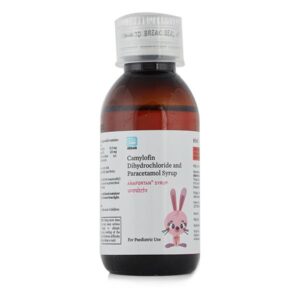PARACETAMOL (ACETAMENOPHEN) + CAMYLOFIN
Paracetamol (acetamenophen): Paracetamol, also known as acetaminophen, is a commonly used drug for pain relief and reducing fever. It belongs to the class of medications called analgesics (pain relievers) and antipyretics (fever reducers).
Paracetamol works by blocking the production of certain chemicals in the brain that signal pain and fever. It is thought to inhibit the enzyme cyclooxygenase (COX), mainly COX-2, which is involved in the synthesis of prostaglandins. By reducing the levels of prostaglandins, it helps to alleviate pain and reduce fever.
Paracetamol is typically administered orally and is available in various formulations such as tablets, capsules, suspensions, and syrups. The recommended dose for adults and children over 12 years of age is 325-650 mg every 4-6 hours, with a maximum daily dose of 4 grams (4000 mg). For children, the dose is based on their weight and age, and it is important to follow the instructions provided by a healthcare professional or the product label.
While paracetamol is generally considered safe when used as directed, it can cause side effects in some individuals. Common side effects may include nausea, vomiting, stomach pain, and rash. Rare but serious side effects can include liver damage, especially if taken in excessive doses or for prolonged periods. It is essential to avoid alcohol consumption while taking paracetamol, as it can increase the risk of liver damage.
It is important to note that paracetamol may interact with other medications. It is advisable to inform your healthcare provider about any other medications you are taking, including over-the-counter drugs, herbs, or supplements, to avoid potential drug interactions.
It is always recommended to consult a healthcare professional for proper dosing and to ensure paracetamol is appropriate and safe for you, especially if you have any pre-existing medical conditions or are taking other medications.
Camylofin: Camylofin is a medication used for the treatment of various gastrointestinal and genitourinary disorders. It is primarily prescribed as a smooth muscle relaxant.
The main mechanism of action of Camylofin is the inhibition of calcium influx into smooth muscle cells. This leads to the relaxation of smooth muscles in the gastrointestinal and genitourinary systems, reducing spasms and improving symptoms associated with certain conditions.
Camylofin is typically administered orally in the form of tablets or syrup. The recommended dose and frequency of administration may vary depending on the age, weight, and condition of the patient. It is crucial to follow the instructions provided by the healthcare professional or as mentioned on the medication label.
As with any medication, Camylofin may cause some side effects. The common side effects include drowsiness, dizziness, dry mouth, blurred vision, and constipation. These side effects are usually mild and temporary, but if they persist or worsen, it is important to consult a healthcare professional.
In rare cases, some individuals may experience more serious side effects such as irregular heartbeat, difficulty breathing, severe allergic reactions, or signs of liver problems. If any of these severe side effects occur, it is essential to seek immediate medical attention.
It is crucial to inform the healthcare professional about any existing medical conditions, allergies, or other medications being taken before starting Camylofin, as it may interact with certain drugs and pose additional risks.
Overall, Camylofin is a smooth muscle relaxant used to alleviate symptoms of gastrointestinal and genitourinary disorders. It is important to use it as directed by a healthcare professional and be aware of potential side effects.

